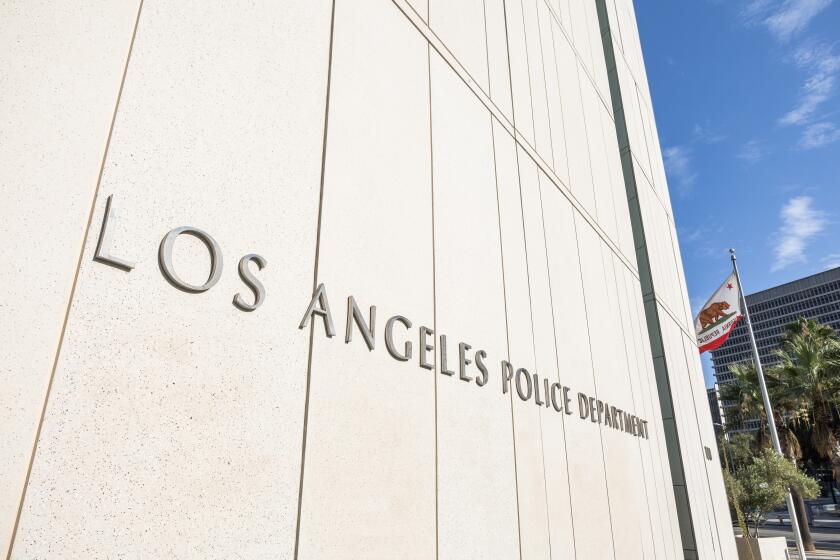Attempt to tighten ‘McMansion’ law spurs outcry
- Share via
In Los Angeles neighborhoods where big, boxy houses were popping up like fungi on an overwatered lawn, the expectations of mansionization opponents soared seven years ago when a new city ordinance promised to halt out-of-scale development.
Alarmed residents citywide have long contended that the 2008 “baseline mansionization” ordinance had loopholes the size of dirt haulers and concrete mixers, which continue to raise dust and block traffic in areas beset by a tsunami of tear-downs and construction.
Now a multi-pronged proposal to temporarily tighten restrictions while city planners spend 18 months to two years devising a permanent fix is spawning its own chorus of dismay from detractors who say that developers of oversize homes are having undue influence on City Hall.
These critics say the draft “interim control ordinances,” scheduled to be heard Tuesday by the City Council’s planning and land use management committee, contain such confusing variations, bonuses and exemptions that they could easily make the situation worse.
“The language is so murky in the [interim control ordinances] provisions that it is nearly impossible to figure them out,” said Dick Platkin, a retired city planner who has long battled mansionization in his Beverly Grove neighborhood.
Los Angeles’ 2008 rules were intended to prevent the construction in single-family neighborhoods of puffed-up houses on modest lots. The restrictions curb the size of new and renovated homes based on lot size, but the rules allow “bonuses” of 20% more space than would otherwise be allowed if homeowners or developers do such things as scale back second stories or use environmentally friendly materials.
Also under the 2008 ordinance, residents or developers may exclude the following when computing a house’s total size: 400 square feet for attached garages, 250 square feet for semi-enclosed patios or breezeways and 100 square feet for vaulted entryways.
In many areas, the exemptions and bonuses led to the construction of “McMansions” that neighboring residents said deprived them of light, air and privacy.
After hearing a torrent of complaints, Councilman Paul Koretz proposed in May that the council direct the city Department of City Planning to close the loopholes in the baseline mansionization ordinance.
Planning officials said such changes could not be rushed. Instead, they proposed creation of interim ordinances to govern neighborhoods where residents had complained most vociferously about mansionization.
Koretz, Tom LaBonge and other council members consulted in sometimes testy meetings with neighborhood groups and homeowners associations. In some areas, residents appeared to be of one mind. In others, divisions were sharp and heated.
In the affluent Westside neighborhood of Beverlywood, for example, Koretz found some residents lobbying for tighter restrictions on house size — a limit of 50% of the lot size — and others for looser rules. Among those seeking relaxed rules were many Orthodox Jews, who have gravitated toward the neighborhood because it is within walking distance to synagogues on Pico and Olympic boulevards.
Young, growing Orthodox Jewish families “are in demand of larger homes,” said Scott Krieger, an Orthodox Jew who is on the board of the Beverlywood Homes Assn.
In the end, Koretz acceded to the wishes of Krieger and backers of looser rules, suggesting a 15% square-footage bonus for Beverlywood. Residents who had pushed for tighter limits said Koretz sold them out. Although Koretz personally favors rules that limit mansionization in neighborhoods with relatively small lots, he said of Beverlywood: “Certainly, we don’t want to jam in [unwanted] restrictions.”
The California Country Club Estates section of Cheviot Hills and a portion of the Fairfax district also would get the 15% bonus.
Among neighborhoods likely to breathe a sigh of relief are five that have been pushing to become Historic Preservation Overlay Zones, a designation that helps to protect a neighborhood’s architectural character. For those areas — Sunset Square, Carthay Square, Holmby-Westwood, Oxford Square and El Sereno-Berkshire Craftsman District — the interim control ordinance would establish a temporary moratorium on building and demolition permits.
The other draft ordinances, however, contain a bewildering array of exemptions and bonuses.
Platkin said he found it odd that south Hollywood, La Brea-Hancock, Miracle Mile, Larchmont Heights and Old Granada Hills would retain the square-footage loopholes that Koretz had said should be purged.
The exemptions for covered garages, semi-enclosed patios and vaulted entries would also be allowed under the interim rules. And it appears that new projects in these five neighborhoods would qualify for the 20% size bonus for certain “green” or design features.
Tuesday’s committee meeting promises to draw a crowd of disappointed or flummoxed residents searching for answers.
“With so many different floor area formulas for the many neighborhoods within the district,” said Ron Friedman, a Beverlywood resident who opposes the mansionization trend, “I question whether the [interim control ordinances] can be accurately implemented and enforced.”
Twitter: @MarthaGroves
More to Read
Sign up for Essential California
The most important California stories and recommendations in your inbox every morning.
You may occasionally receive promotional content from the Los Angeles Times.














